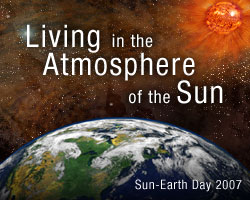National Aeronautics and Space Administration
Goddard Space Flight Center

Sun-Earth Day 2010: Magnetic Storms
Past Sun-Earth Days

- 2009: Our Sun, Yours to Discover
- Join us for Sun-Earth Day and the International Year of Astronomy as we explore, experience, study and predict our sun.

- 2008: Space Weather Around the World
- For Sun-Earth Day 2008, we will engage a world-wide audience in the celebration of the International Heliophysical Year (IHY).

- 2007: Living in the Atmosphere of the Sun
- We kick off the International Heliospheric Year celebration with Living in the Atmosphere of the Sun!

- 2006: Eclipse, in a Different Light
- Join us in an extraordinary journey of exploration, discovery and understanding of the total solar eclipse of March 29, 2006!

- 2005: Ancient Observatories Timeless Knowledge
- The Ancient Observatory theme for 2005 features solar alignments with structures that mark the equinoxes and/or solstices.

- 2004: Venus Transit
- Learn more about the transit of Venus that occurred on June 8, 2004. In this site you will find comparisons of Venus with Earth and Mars, calculations of the distances to nearby stars, and the use of transits to identify extra-solar planets.
NASA Fact
The most powerful solar flare in the last 500 years occurred on September 2, 1859 and was sighted by two astronomers who happened to be looking at the sun at exactly the right time!
